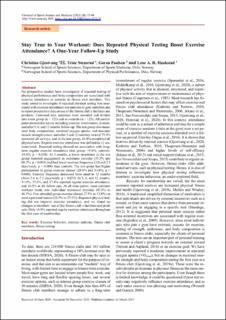| dc.contributor.author | Gjestvang, Christina | |
| dc.contributor.author | Stensrud, Trine | |
| dc.contributor.author | Paulsen, Gøran | |
| dc.contributor.author | Haakstad, Lene Annette Hagen | |
| dc.date.accessioned | 2021-11-08T14:32:23Z | |
| dc.date.available | 2021-11-08T14:32:23Z | |
| dc.date.created | 2021-02-09T09:56:18Z | |
| dc.date.issued | 2021 | |
| dc.identifier.citation | Journal of Sports Science and Medicine. 2021, 20(1), 35-44. | en_US |
| dc.identifier.issn | 1303-2968 | |
| dc.identifier.uri | https://hdl.handle.net/11250/2828432 | |
| dc.description | This work is licensed under a Creative Commons Attribution-NonCommercial-NoDerivatives 4.0 International License. | en_US |
| dc.description.abstract | No prospective studies have investigated if repeated testing of physical performance and body composition are associated with exercise attendance or patterns in fitness club members. This study aimed to investigate if repeated physical testing was associated with exercise attendance and patterns in gym members and to report prospective data on use of the fitness club’s facilities and products. Untrained new members were recruited and divided into a test group (n = 125) and as controls (n = 125). All participants answered a survey including exercise involvement, at onset, and after 3, 6, and 12 months follow-up. The test group also measured body composition, maximal oxygen uptake, and maximal muscle strength (onset, and after 3 and 12 months). In total 73.6% answered all surveys, and in the test group, 44.8% completed all physical tests. Regular exercise attendance was defined as ≥2 sessions/week. Repeated testing showed no association with long-term regular exercise attendance (test group: 19.6%, controls: 19.8%; p = 0.638). At 3 months, a lower proportion in the test group reported engagement in resistance exercise (35.3% and 60.2%; p = 0.003) and had lower exercise frequency (2.0 and 2.6 days/week; p = 0.008) than controls. The test group had higher participation in group exercise classes (28.0% and 13.6%; p = 0.040). Exercise frequency decreased from onset to 12 months (from 2.6 to 2.2 days/week; p = 0.025) At 3, 6, and 12 months, 51.8%, 37.6%, and 37.4% reported regular exercise attendance, and 16.9% at all follow-ups. At all time-points, most common workout mode was individual resistance exercise (43.8% to 46.3%). Few attended group exercise classes (7.5% to 13.8%) or used a personal trainer (22.5% to 27.5%). Repeated physical testing did not improve exercise attendance, and we found no changes in members` use of the fitness club’s facilities and products. Only 16.9% reported regular exercise attendance throughout the first year of membership. | en_US |
| dc.language.iso | eng | en_US |
| dc.subject | exercise behavior | en_US |
| dc.subject | exercise patterns | en_US |
| dc.subject | fitness club members | en_US |
| dc.subject | fitness testing | en_US |
| dc.title | Stay true to your workout: Does repeated physical testing boost exercise attendance?: A one-year follow-up study | en_US |
| dc.type | Peer reviewed | en_US |
| dc.type | Journal article | en_US |
| dc.description.version | publishedVersion | en_US |
| dc.rights.holder | © Journal of Sports Science and Medicine (2021) | en_US |
| dc.source.pagenumber | 35-44 | en_US |
| dc.source.volume | 20 | en_US |
| dc.source.journal | Journal of Sports Science and Medicine | en_US |
| dc.source.issue | 1 | en_US |
| dc.identifier.doi | 10.52082/jssm.2021.35 | |
| dc.identifier.cristin | 1887946 | |
| dc.description.localcode | Institutt for idrettsmedisinske fag / Department of Sports Medicine | en_US |
| dc.description.localcode | Institutt for fysisk prestasjonsevne / Department of Physical Performance | en_US |
| cristin.ispublished | true | |
| cristin.fulltext | original | |
| cristin.qualitycode | 1 | |
